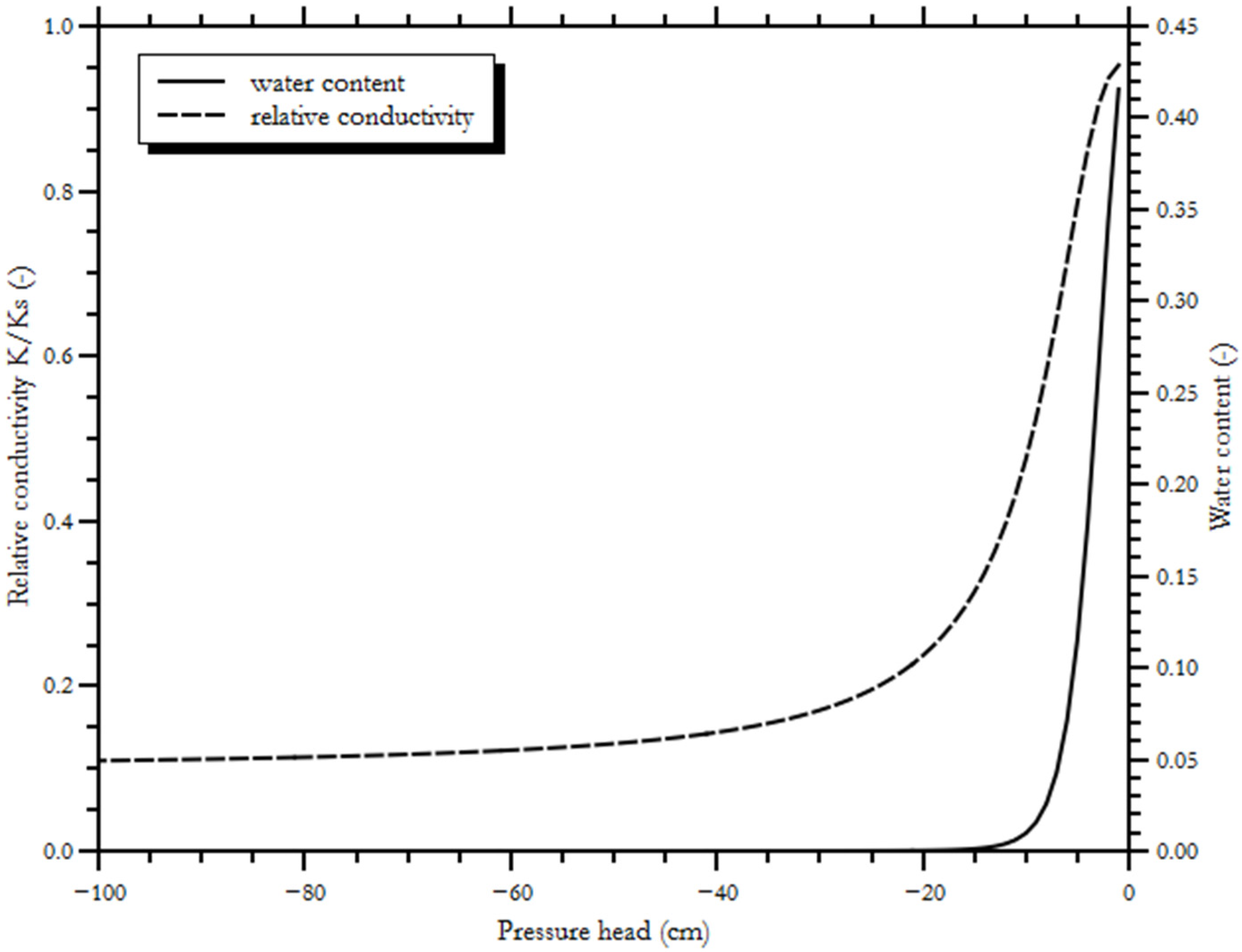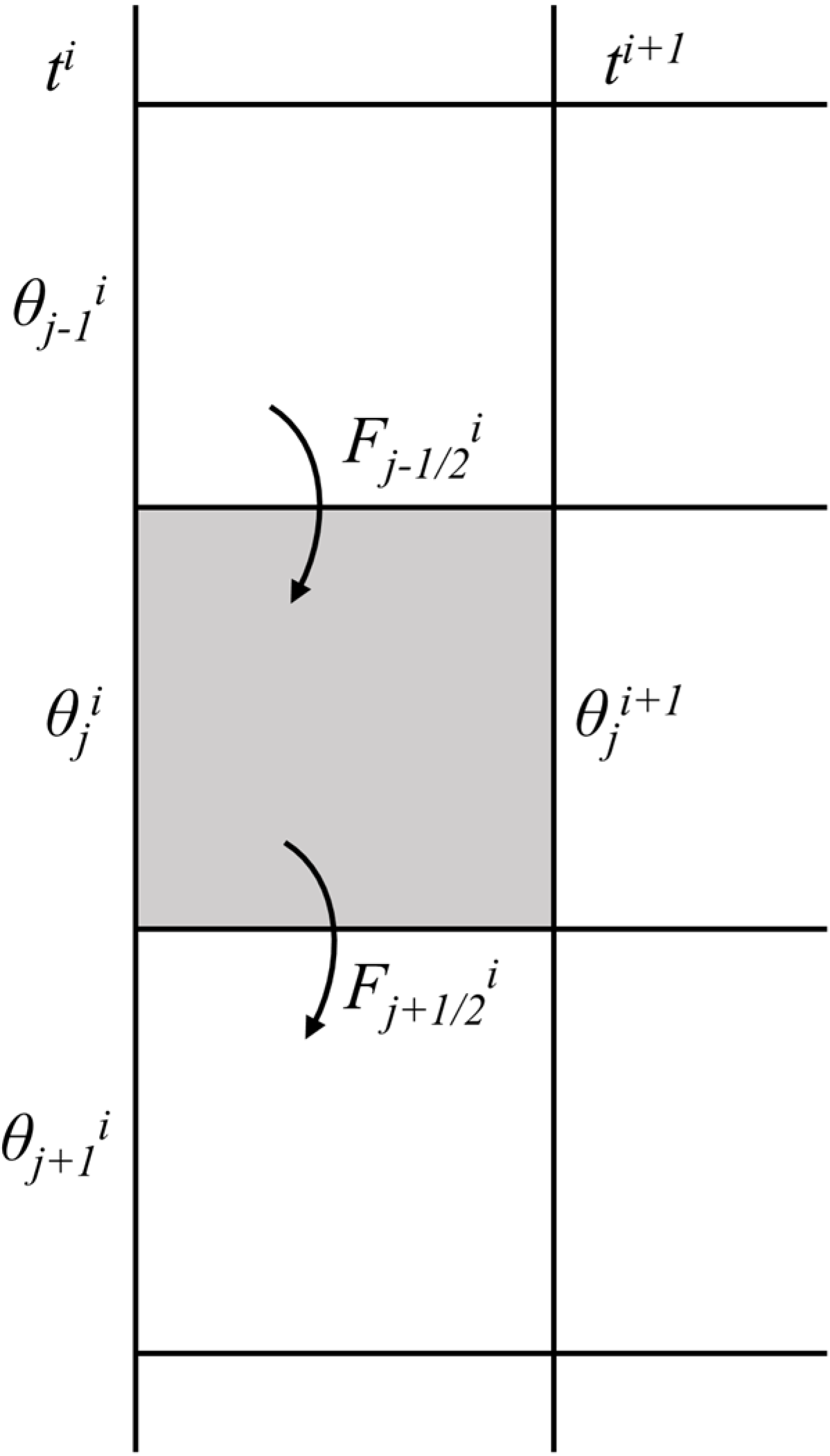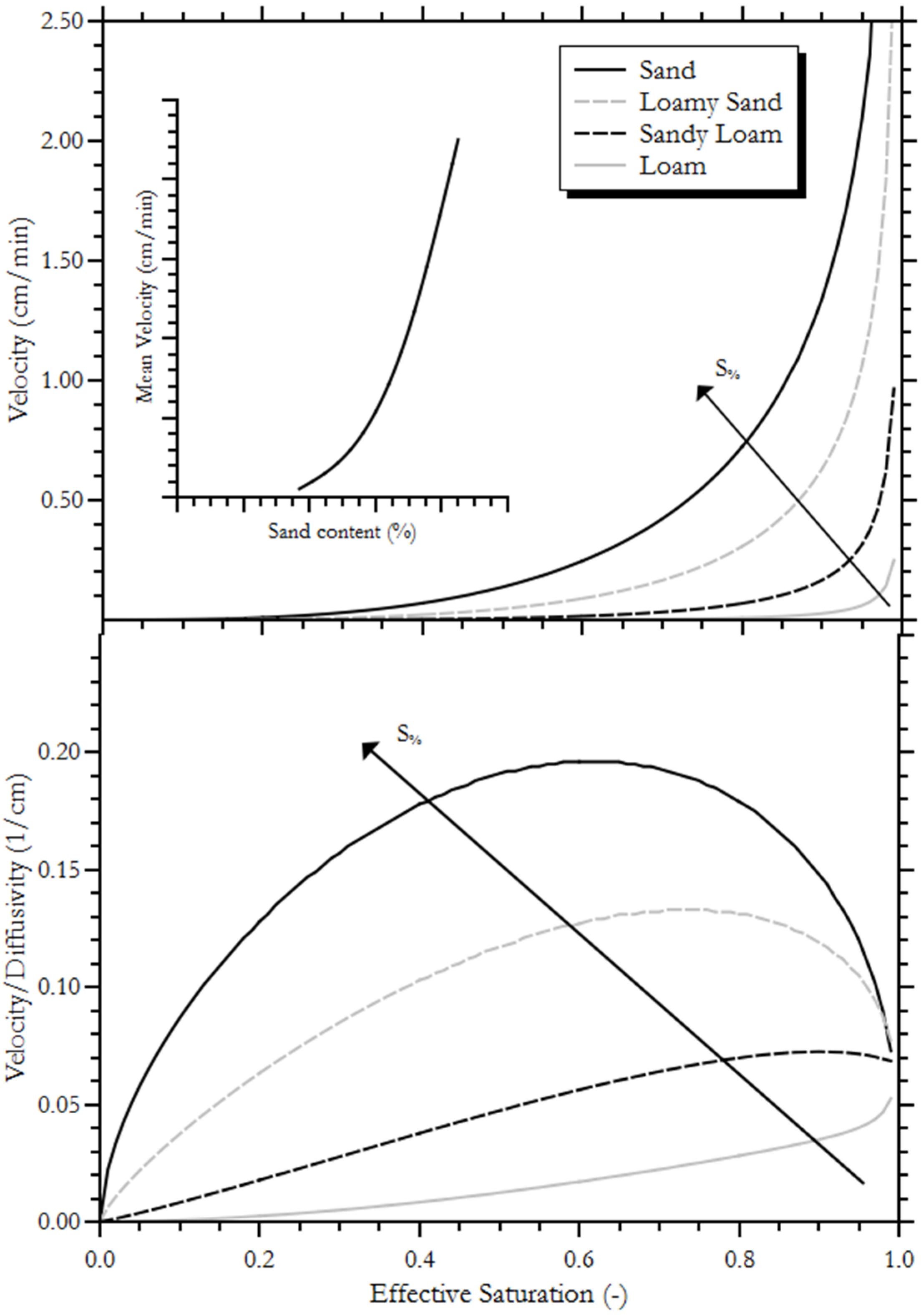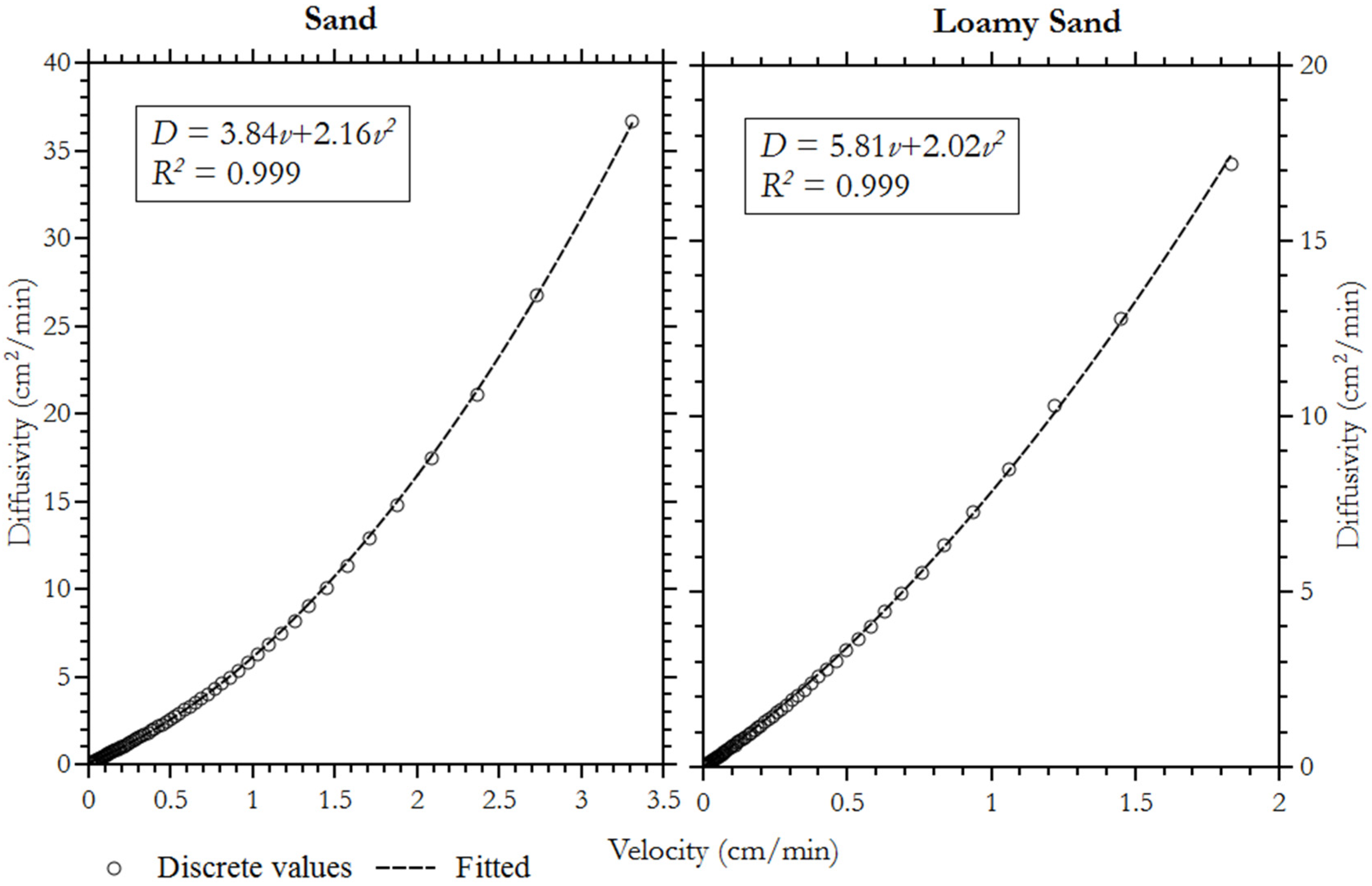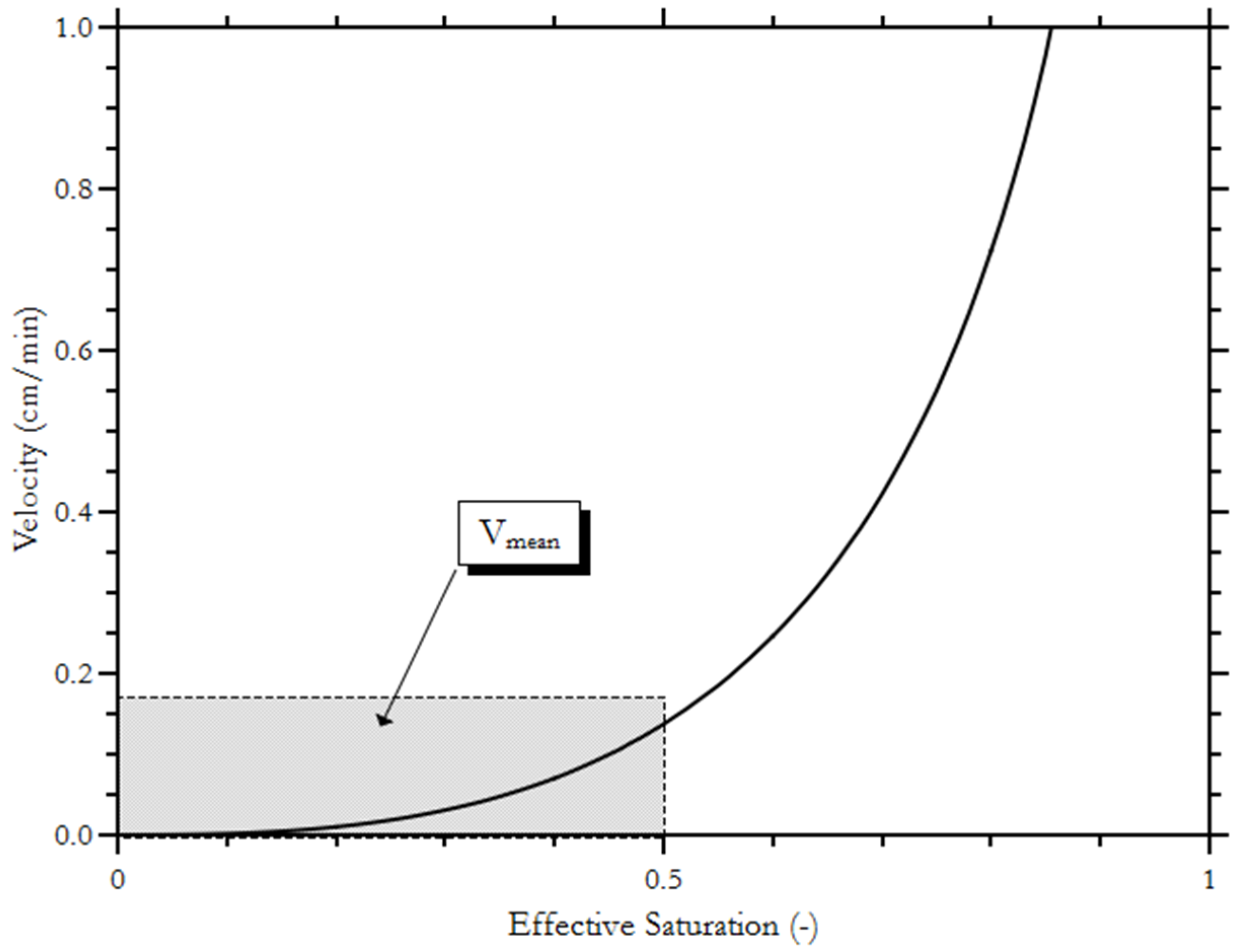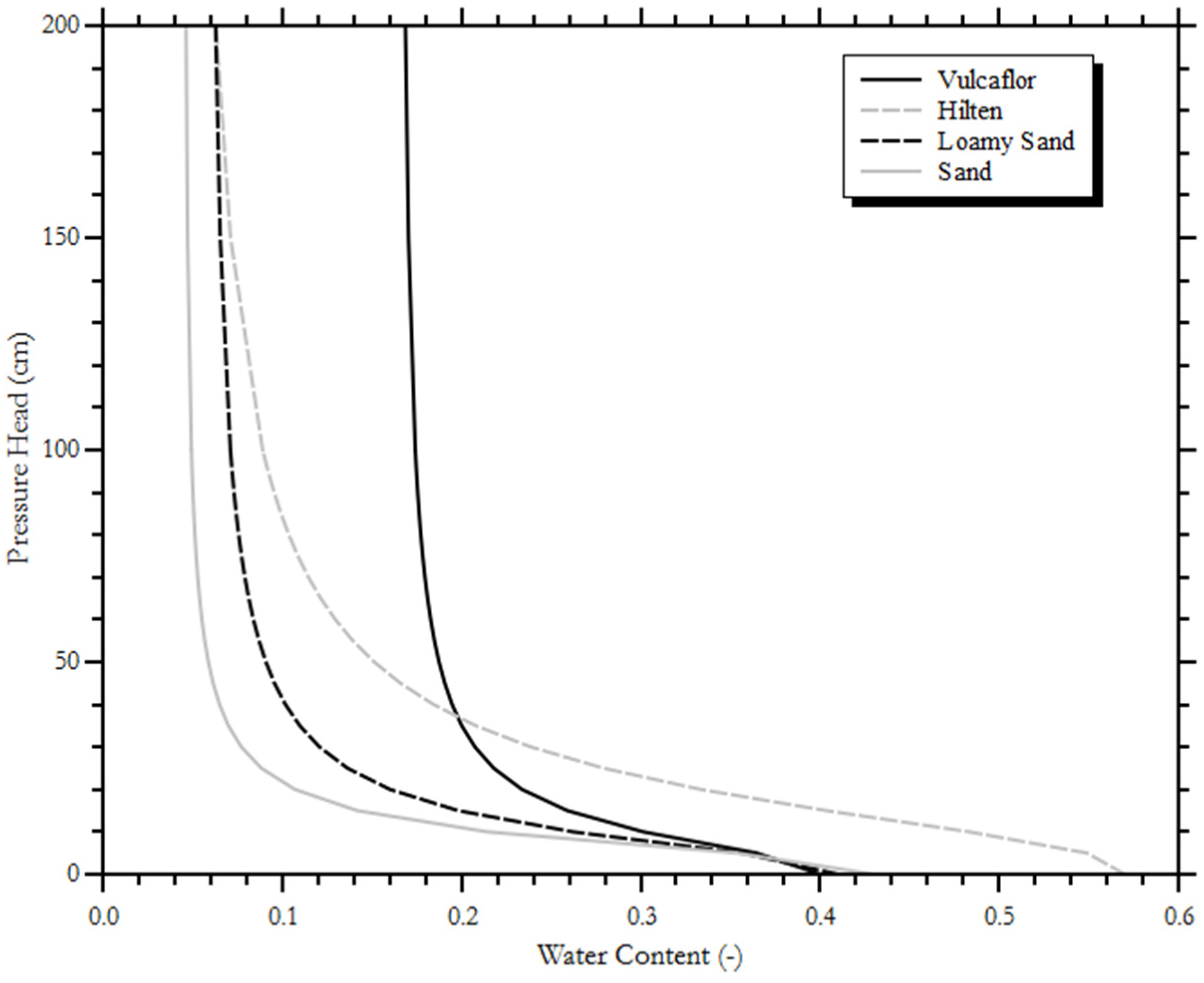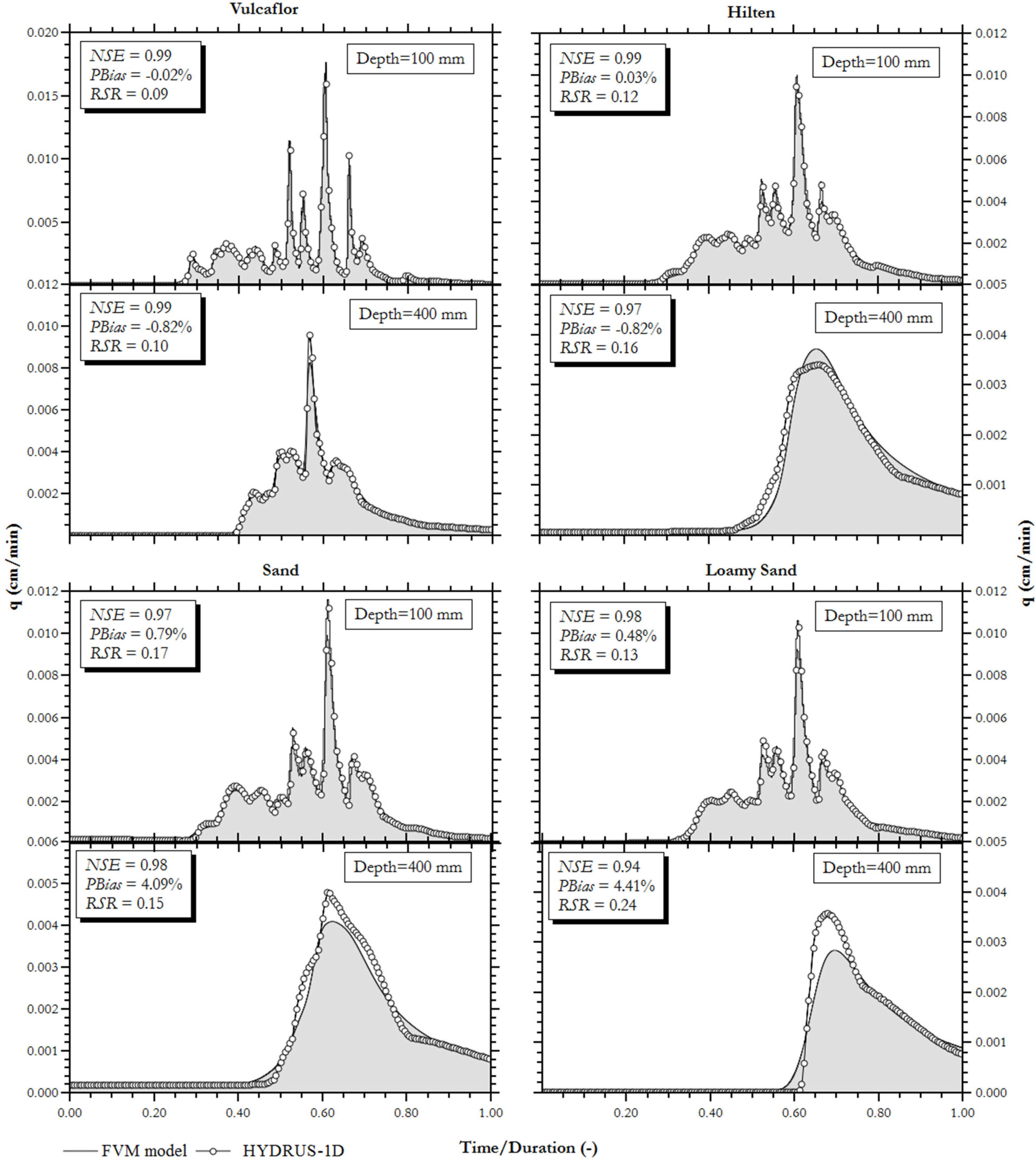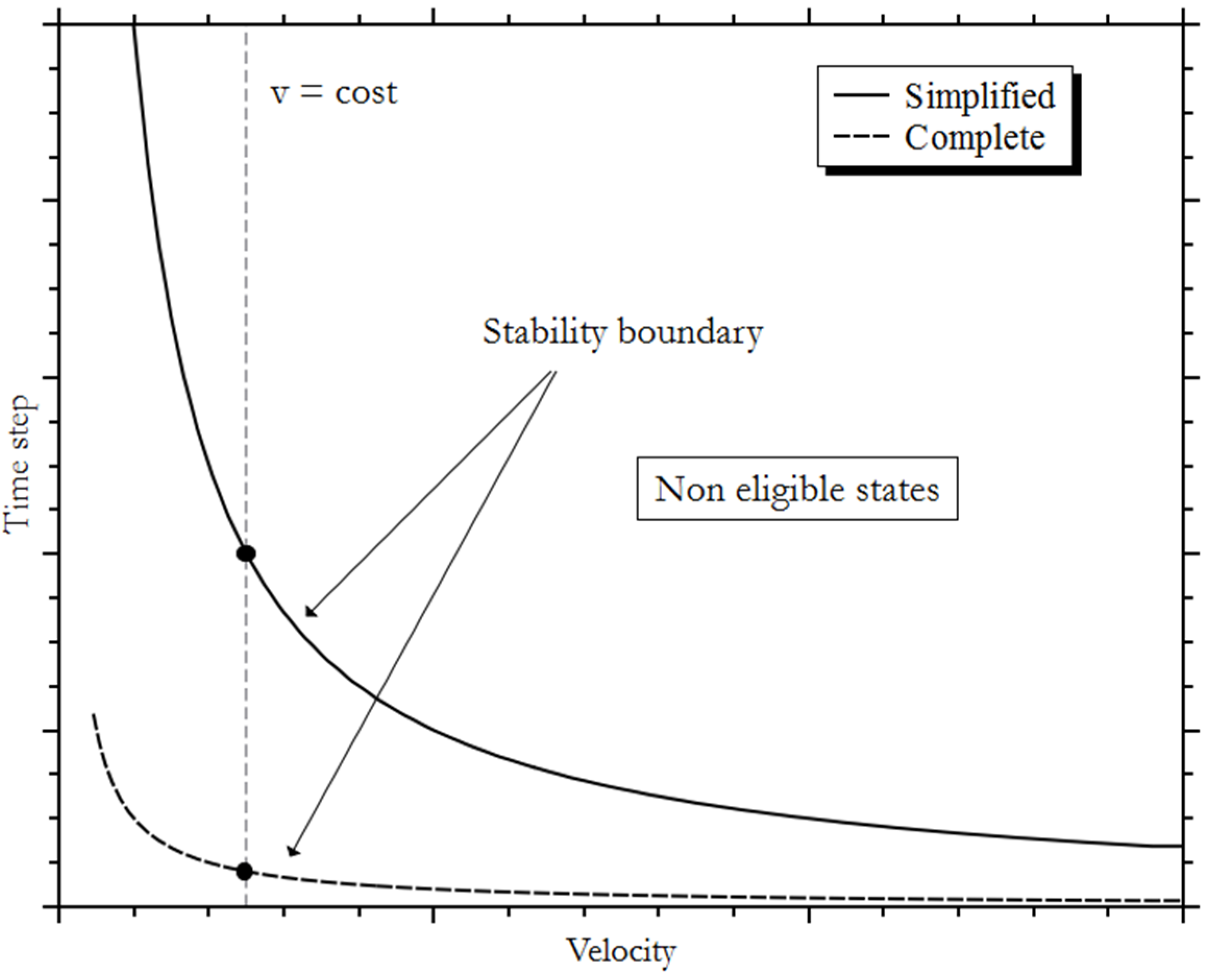2.1. Mathematical Model and Governing Equation
Flow in a variably saturated porous medium can be described by the Richards equation [
8], which can be written as:
where θ is the water content (L
3/L
3), ψ is the suction head (L),
K is the unsaturated hydraulic conductivity (L/T),
t is the time (T) and
z is the depth (L) (positive downward). The Richards equation can be derived by combining two physical laws:
- -
The continuity equation, written in its differential form:
where
q is the liquid flow, and
- -
The Richards equation may be written in three different forms:
where
C(ψ) is the hydraulic capacity function (1/L) and
D(θ) is the soil water diffusivity (L
2/T). The main advantage of the moisture-based form is that it is expressed in terms of the conserved variable. The pressure-based form can handle discontinuities in the porous media, but may lead to significant mass balance errors. The mixed form can conserve mass, and allows for saturated flows and heterogeneity in the porous medium.
Mathematically, the Richards equation has the characteristics of an advection-diffusion equation. It contains a diffusive term associated with soil water diffusivity and an advective term associated with the depth
z. These characteristics emerge if we apply a Kirchhoff transformation to the pressure-form of the Richards equation. The Kirchhoff transformation introduces a new variable
u:
By substituting Equation (8) into Equation (6) the following equation is obtained:
where
D(
u) is the soil moisture diffusivity and
v(
u) is the soil moisture velocity, defined as:
The transformed Richards Equation (9) is an advection-diffusion equation where an advective term, associated with the soil moisture velocity v, and a diffusive term, associated with the soil moisture diffusivity D, are clearly highlighted.
Unsaturated Soil Constitutive Models
This work builds on the Mualem-van Genuchten (MG) model [
9], which is used to define water content θ(ψ) and unsaturated hydraulic conductivity
K(θ) (
Figure 1). The MG model is used herein, because of its widespread use in the literature and general reliability. The MG model can be expressed as:
where θ
r (L
3/L
3) is the residual water content, θ
s (L
3/L
3) is the saturated water content,
Ks (L/T) is the saturated hydraulic conductivity,
n is a parameter which measures pore-size distribution and α (L
−1) is a parameter related to the inverse of the air-entry pressure.
L indicates the tortuosity and is usually assumed to be
L = 0.5 [
10].
Se is the effective saturation (L
3/L
3).
Figure 1.
Mualem-van Genuchten soil model.
Figure 1.
Mualem-van Genuchten soil model.
2.2. Numerical Model
As stated in the introduction, the main purpose of this research is to develop a numerical model that conserves mass and is robust, computationally efficient and easy to implement. Most of the existing models are based on numerical approximations of the Richards equation, which has no general analytical solution. The techniques employed include the Finite Difference method (FDM) [
11]; the Finite Element Method (FEM) [
12,
13]; and the Finite Volume Method (FVM) [
14,
15,
16,
17,
18]. The use of the FDM and FEM is reported in the literature most frequently, because they offer computational advantages for solving parabolic-elliptic equations, such as the Richards equation. However, the FDM and FEM often suffer, to some degree, from mass balance errors as well as numerical oscillations, and additional numerical problems may appear when the gravitational term becomes important [
19]. This case is frequently encountered in highly permeable soils, where the advective term of Equation (9) becomes important. In that case, the Richards equation tends to have a hyperbolic nature.
On the other hand, the FVM is well suited for numerical simulations of mass conservation laws and has been used extensively in different engineering fields, such as petroleum engineering, fluid mechanics and hydrology. The FVM has many important features: it conserves mass both locally and globally, may be applied to arbitrary geometries and leads to robust computational schemes. The reason the FVM conserves mass locally follows from the fact that it applies the continuity equation to each control volume of the domain. For these reasons, the FVM was selected here for the definition of the numerical scheme.
2.2.1. Finite Volume Framework
Equation (1) can be integrated over a control volume Ω:
Applying the divergence theorem to the right term yields:
where σ is the vector normal to the surface
SΩ of the control volume. After the control volume is discretized into a finite volume
Vj and the surface
SΩ is discretized into
Nω faces of area
Aω, the finite volume scheme is obtained:
where
dω represents the distance between two adjacent cells. The vertical 1D simplification can be written as:
where δ
z = zj+1 −
zj represents the distance between the two adjacent cell centers and
Kj±1/2 represents the interface conductivity, which must be interpolated or approximated from cell center values.
Several techniques had been proposed in the literature for the computation of interface conductivity [
20], but no clear conclusions have been drawn. The arithmetic mean is used in many studies and models, including the widely accepted HYDRUS model, but it can lead to spurious oscillations in the solution. Various studies [
21] indicate that only the upstream mean preserves monotonicity in the solution.
The upwind discretization is rarely used by hydrogeologists in practical applications, but Forsyth and Kropinsky [
22] and Furhmann and Langmach [
23] showed that the upwind technique helps to avoid numerical oscillations in the solution. In order to avoid numerical problems, the discretization scheme must be monotonic, and monotonicity can be assured only if the scheme is first-order accurate [
24]. The upwind discretization is first-order accurate and unconditionally monotonic, provided that the stability condition is satisfied.
The main disadvantage of the upwind scheme is that it introduces false numerical diffusion into the solution. The numerical diffusion (
ND) can be determined by analyzing the second-order approximation error and can be described as:
where
v is the generic velocity. It can be seen that the numerical diffusion is directly related to the velocity and the mesh size, and, therefore, to attenuate the numerical diffusion, it is necessary to use a very fine mesh, depending on the velocity values.
Since mass conservation and robustness are among the desired features of the proposed model, the upwind discretization in space is used. This guarantees monotonicity of the solution and avoids numerical oscillations, within the limits imposed by the stability condition.
2.2.2. Explicit Formulation
As said previously, together with robustness and mass conservation, other required characteristics for the proposed model are computational efficiency and ease of implementation. The Richards equation can be solved by using explicit or implicit formulation in time. The implicit formulation leads to an unconditionally stable scheme, but it is computationally demanding and hard to implement, because of the need to solve, at each time step, a nonlinear equation through iterative procedures like the Picard, Newton-Raphson, or Secant methods.
On the other hand, the explicit formulation is easy to implement, computationally efficient and leads to a conservative scheme, while being conditionally stable. For these reasons, the explicit formulation in time was chosen and used.
In one space dimension, the Finite Volume Method is based on subdividing the domain into finite grid cells and on approximation of the flux on the boundary of these cells (
Figure 2).
Figure 2.
Illustration of the Finite Volume Scheme for updating the cell values by the boundary fluxes.
Figure 2.
Illustration of the Finite Volume Scheme for updating the cell values by the boundary fluxes.
The general scheme for the Finite Volume Method is explained by the following equation:
where
Fij+1/2 is a numerical approximation of the flux along
z = zj+1/2. A fully discrete method is obtained by approximating the average flux based on the θ
i values of the cells that are adjacent to the boundary in question. In the case of the upwind method, the flux through the top edge of the cell is entirely determined by the value θ
ij−1 in the cell above. The numerical flux for the upwind method is written as:
A 1D explicit formulation is obtained by using a forward Euler scheme in time and the upwind discretization in space, with a uniform grid spacing:
where
Q represents the numerical flux:
The 1D explicit finite-volume formulation becomes:
As stated earlier, the explicit formulation is conditionally stable, and for that reason, it imposes some restrictions on time step selection. A necessary, but not sufficient, condition for the stability of a finite volume or finite difference scheme for the resolution of a partial differential equation (PDE) is that the numerical domain of dependence contains the mathematical domain of dependence. This requirement is known as the Courant-Friedrichs-Levy or CFL condition. The Courant number for the Richards equation can be written as [
25]:
where
v is the soil water velocity (LT
−1). The Courant number reflects the importance of the convective flux in the unsaturated flow.
The stability condition for the explicit upwind scheme can be written as:
where
v is the velocity,
D is the diffusivity, Δ
t is the time step and Δ
z is the mesh size. This formulation includes the diffusion number condition.
2.3. Green Roof Substrate
As stated in the introduction, the substrate is one of the most important elements of a green roof; the characteristics of this element strongly influence the hydraulic behaviour of the green roof.
Typical green roof growing media are composed of 80%–90% light-weight aggregate (LWA) and 10%–20% fine material [
26]. LWA provides pore space for air and water and ensures rapid drainage. However, the low organic content and the coarse texture imply that key functions for plant growth must be supplemented, e.g., by cation exchange capacity (CEC) for nutrient retention and chemical buffering and moisture storage and supply. The LWA mainly consists of expanded clay, expanded shale, expanded slate, or similar material. Aggregates are usually mixed with sand and organic matter, in order to provide an adequate portion of fine particulate matter supporting the plants. Recycled clay bricks and crushed concrete may be used as aggregate components. They are not lightweight, but their coarse particles possess high permeability. Extensive green roof substrates are typically 5%–20% organic material. The Forschungsgesellschaft Landschaftsentwiklung Landschaftsbau (FLL) guidelines [
26] recommend a maximum organic content of 65 g/L. A high proportion of organic matter increases water retention capacity and may benefit plant growth, but decreases the GR permeability. Maintaining high permeability in the porous matrix is fundamental for avoiding ponding and surface runoff.
The FLL guidelines further indicates that the combined silt and clay content (d < 0.063 mm) of an extensive green roof should not exceed 15% by mass. Excessive fine particles will reduce substrate permeability and increase weight.
In intensive green roof substrates, the content of silt and clay should not exceed 20%, with an organic content <12%.
In summary, a coarse porous matrix, with a low organic content and high permeability, is characteristic for GR substrates. These features influence the hydraulic behaviour of GRs, especially in terms of the wetting front velocity and characteristics of the unsaturated flow. As pointed out in the literature [
25], velocities and Peclet numbers are higher for coarse soils, and can vary by several orders of magnitude over the saturation field.
It is evident from
Figure 3 that water velocity is directly related to sand content, and in particular, it increases exponentially as the soil becomes coarser. On the other hand, the velocity/diffusivity ratio describes the nature of the unsaturated flow. The definition of such an index is suggested by the similarity between the Richards equation and the advection-dispersion equation. High values of this ratio indicate that the flow is mainly advective, while low values are associated mostly with a diffusive flow characterized by low velocities.
In view of the characteristics of GR substrates, and according to the preceding discussion, the flow in the porous matrix of green roofs must be strongly unsaturated and mainly advective, with high velocities.
Figure 3.
Water velocity and ratio velocity/diffusivity for four selected typical soils.
Figure 3.
Water velocity and ratio velocity/diffusivity for four selected typical soils.
2.4. Simplified Formulation
From a computational point of view, within the limits of the stability condition, the upwind discretization guarantees the robustness and monotonicity of the numerical scheme, but introduces false numerical diffusion into the solution. To attenuate this diffusion, it is necessary to use a very fine mesh. However, this condition for an explicit scheme imposes the requirement of selecting very small time steps, in order to satisfy the stability condition [
27], and results in high computational requirements. On the other hand, green roof substrates are characterized by strongly unsaturated flows with high velocities, and under such conditions, the diffusive term becomes less important. From these considerations arises the idea of proposing a simplified formulation of the Richards equation, in which the diffusive term is neglected. The Darcy equations becomes:
By substituting this relation into the continuity Equation (2), the following equation is obtained:
The governing equation then becomes a hyperbolic PDE, in which the time variation of the volumetric water content depends only on the divergence of the unsaturated hydraulic conductivity.
The 1D explicit finite formulation, using the upwind discretization in space, can be written as:
where
Q represents the numerical flux, defined as:
The 1D explicit finite-volume formulation becomes:
Obviously, the neglect of the diffusive term in the mathematical formulation introduces an error into the solution, even for highly permeable soils where the flow is predominantly controlled by gravity, as is the case in the green roof substrates. However, this effect can be offset by the numerical diffusion introduced by the upwind scheme by appropriately selecting the mesh size in the discretization of the domain.
The numerical diffusion (
ND) introduced by the upwind scheme arises from a first-order approximation of the spatial derivative
∂θ/∂
z, this is evident if we examine the Taylor series expansion:
The first derivative can be written as:
The Equation (30) can be written as:
where the derivative ∂
K(
θ)
/∂
z is the soil water velocity
v. By substituting Equation (35) into Equation (36) we obtain:
The higher order terms are much smaller than the second derivative, so they can be ignored. The Equation (37) becomes:
where
ND is the numerical diffusion defined as in Equation (21).
In order to produce accurate results, the numerical diffusion (
ND) introduced by the upwind scheme must compensate for the diffusive term neglected in Equation (30). Equation (6) can be written as:
Equation (41) is similar to Equation (38). Combining these two equations leads to:
This relationship regulates the amount of numerical diffusion that must be introduced in order to compensate for the nonlinear diffusive term ignored in Equation (6). This value cannot be determined a priori due to the variation of θ along z during the simulation. For these reasons, in order to have a first approximation of the value of ND, some assumptions must be made.
A first approximation of ND can be obtained by equating the numerical diffusion to the soil water diffusivity. However, this type of approximation leads to poor accuracy due to the neglect of the effect of second term on the right side of Equation (43). This term is directly related to the first and second derivatives of the soil moisture profile and cannot be determined a priori, without some simplifying assumptions.
In this research, the mesh size was determined by assuming:
Combining Equations (44) and (21) leads to:
The mesh size Δ
z, defined in Equation (45), is the function of two variables: soil water diffusivity
D and soil water velocity
v. In order to simplify the above equation, we tried to find a relationship between
D and
v. In
Figure 4, a scatter plot of the discrete values of the two variables
v and
D is presented.
Figure 4.
Parabolic relation between velocity and diffusivity.
Figure 4.
Parabolic relation between velocity and diffusivity.
We performed a polynomial regression on the discrete values using the algorithm from Levenberg-Marquadt. As shown in
Figure 4, the soil water diffusivity is related to the water velocity by a parabolic relationship, which can be written as:
where λ and ω are two parameters that depend on the soil type. The Pearson coefficient
R2 for the two-polynomial regression is very high.
Combining Equation (46) with Equation (45) leads to:
For a given velocity value, it is possible to determine the mesh size that ensures a consistent numerical diffusion.
During the rainfall event, the velocity of the wetting front in the substrate is highly variable, depending on the soil characteristics. Green roof substrates are characterized by high permeability that implies fast drainage and low moisture content of the substrate during rainfall events [
28]. As already stated in the literature, the saturation degree for green roof substrates does not exceed 50% [
29,
30,
31]. For these reasons, the mesh size Δ
z is computed by assuming that the velocity in the green roof substrate varies between 0% and 50%, and calculating a mean value in this range (
Figure 5). By substituting this value into Equation (47), it is possible to obtain the value of the mesh size Δ
z.
Figure 5.
Computation of the velocity value for the determination of the mesh size as indicated in Equation (47).
Figure 5.
Computation of the velocity value for the determination of the mesh size as indicated in Equation (47).
2.5. Model Performance Evaluation
The proposed Finite Volume solution was compared to numerical simulations performed using HYDRUS-1D [
32]. HYDRUS-1D is a finite-element software that numerically solves the Richards equation for saturated-unsaturated water flows and it is one of the best documented and most widely used codes. In view of its reliability, HYDRUS-1D has been used in the literature as a benchmark for the validation of different alternative models [
11,
33], and therefore, it was used in this study as well for comparing the outflow rates from the green roof substrate. The outflow is one of the most important hydraulic characteristics in the analysis of a green roof exposed to rainfall; it provides information on the retention and peak attenuation capacity of the green roof, and for these reasons, accurate modelling of the GR outflow is particularly needed.
In order to perform the comparison between the two models, boundary conditions must be defined. Boundary conditions of interest for 1D vertical flow are only the top and bottom boundaries. In this study, two Neumann boundary conditions have been applied.
Neumann boundary conditions specify the value of the flux in the direction normal to the boundary considered. For the top boundary, the infiltration process has been simulated by imposing a Neumann condition, specifying the value of the flux.
Precisely, when dealing with infiltration fluxes at the soil surface, the most widely used boundary condition is the soil-atmosphere interface condition, which permits switching between the Neumann and Dirichlet boundary conditions depending on the state of the soil surface. During infiltration a Neumann condition is applied. If the applied flux is larger than the saturated hydraulic conductivity, then positive pressures appear at the surface, which corresponds to the formation of ponding on the soil surface. At this point the boundary condition switches to the Dirichlet boundary condition. However, as stated previously, green roof substrates are designed to avoid the formation of ponding on the surface, which is why the Neumann boundary condition has been implemented.
For the bottom boundary condition, a free drainage condition has been used. The free drainage condition represents vertical flow of water through the bottom of the soil towards a distant groundwater table. This condition is of the Neumann type.
The same boundary conditions have been selected in HYDRUS. In particular, an atmospheric boundary condition with surface runoff for the top boundary, and a free drainage condition for the bottom.
For a quantitative assessment of the model performance, several statistical indices were found in the literature. One of the most important features of a numerical scheme to be evaluated is its ability to conserve mass over the entire domain. Such conservation is an essential condition for a numerical scheme. To measure the ability of the model to conserve mass, the mass balance ratio proposed by Celia [
10] can be used:
where θ
0 is the initial mass in the domain (L
3L
−3), θ
n is the final mass (L
3L
−3),
qin is the influent flow in the domain (LT
−1),
qef is the effluent (LT
−1), Δ
z is the mesh size (L), Δ
t is the time step (T),
N is the number of finite volume elements of the domain, and
i is the time index.
The mass balance ratio is a necessary, but not sufficient, condition for acceptability of a numerical model. In order to compare the proposed model with HYDRUS-1D, three statistical indices were selected.
The Nash-Sutcliffe Efficiency (
NSE) is one of the most widely used indices for characterizing the overall fit of hydrographs [
34]. The
NSE is computed as follows:
where
is the ith reference value,
is the ith simulated value, and
Qmeanobs is the mean value of observed data. NSE coefficient ranges between −∞ and 1.0, in the case of a perfect agreement; generally, values 0 and 1.0 are considered acceptable.
Percent bias (
PBias) measures the average tendency of the model to overestimate or underestimate the counterpart [
35]. Small values indicate good performance from the model, negative values indicate overestimation, and positive values indicate underestimation. PBias is calculated as follows:
PBias was selected for its ability to clearly indicate poor model performance.
Various error indices are commonly used for model evaluations. The Mean Absolute Error (MAE), Mean Square Error (MSE) and Root Mean Square Error (
RMSE) are most widely used. The smaller the error value, the better the model performance, but only Singh and Bengtsson [
34] have published guidelines, based on the observations of standard deviations, on what magnitude of small
RMSEs is acceptable. Following this guideline, the
RMSE-observations/standard deviation ratio (
RSR) was used. The
RSR is calculated as the ratio of the
RMSE and the standard deviation of reference data, as shown in Equation (34):
The RSR varies from the optimal value of 0 to large positive values.
The proposed model has been implemented in the Python programming language.
